Hey there, aquarium enthusiasts! Do you want to add some life and color to your aquarium without having to struggle with complicated lighting requirements? Then you’re in luck because I’m here to introduce you to the best low light aquarium plants that not only look great but are also easy to care for.
As someone who loves creating a natural and vibrant environment for my aquatic pets, I know how tough it can be to keep the right plants in your aquarium. That’s why I’ve put together this list of the 39 best low light aquarium plants that can help you take the stress out of aquarium maintenance.
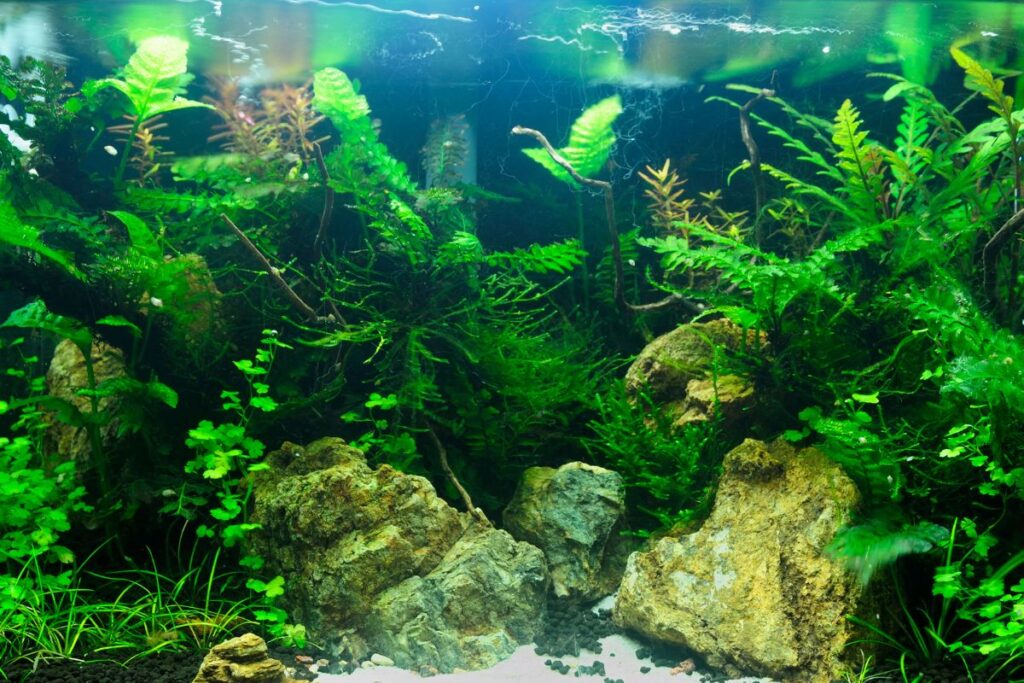
Contents
- 1 Best Low Light Aquarium Plants
- 1.1 Java Fern
- 1.2 Anubias Barteri
- 1.3 Marimo Moss Balls
- 1.4 Amazon Sword
- 1.5 Cryptocoryne Lucens
- 1.6 Vallisneria Americana
- 1.7 Dwarf Sagittaria
- 1.8 Java Moss
- 1.9 Pearl Weed
- 1.10 Anacharis
- 1.11 Rose Sword Plant
- 1.12 Water Sprite
- 1.13 Hornwort
- 1.14 Christmas Moss
- 1.15 Bucephalandra
- 1.16 Cryptocoryne Wendtii
- 1.17 Dwarf Hairgrass
- 1.18 Floating Fern
- 1.19 Ludwigia Repens
- 1.20 Anubias Nana
- 1.21 African Water Fern
- 1.22 Green Hygro
- 1.23 Sunset Hygro
- 1.24 Rotala Rotundifolia
- 1.25 Rotala Indica
- 1.26 Parrots Feather
- 1.27 Moneywort
- 1.28 Brazilian Pennywort
- 1.29 Cryptocoryne Balansae
- 1.30 Cryptocoryne Spiralis
- 1.31 Cryptocoryne Usteriana
- 1.32 Guppy Grass
- 1.33 Pelia Moss
- 1.34 Waterwheel Plant
- 1.35 Bacopa
- 1.36 American Waterweed
- 1.37 Micro Crypt
- 1.38 Duckweed
- 1.39 Cryptocoryne Lutea
- 2 FAQs
- 3 Conclusion
Best Low Light Aquarium Plants
Believe me, I’ve been where you are and I know how tough it can be to find the right plants that can thrive without intense lighting. But with these low-light aquarium plants, you can take your aquarium game to the next level without all the hard work. So, buckle up and get ready to transform your aquarium into a beautiful and natural habitat for all your aquatic friends with the help of the following low light aquarium plants.
Java Fern
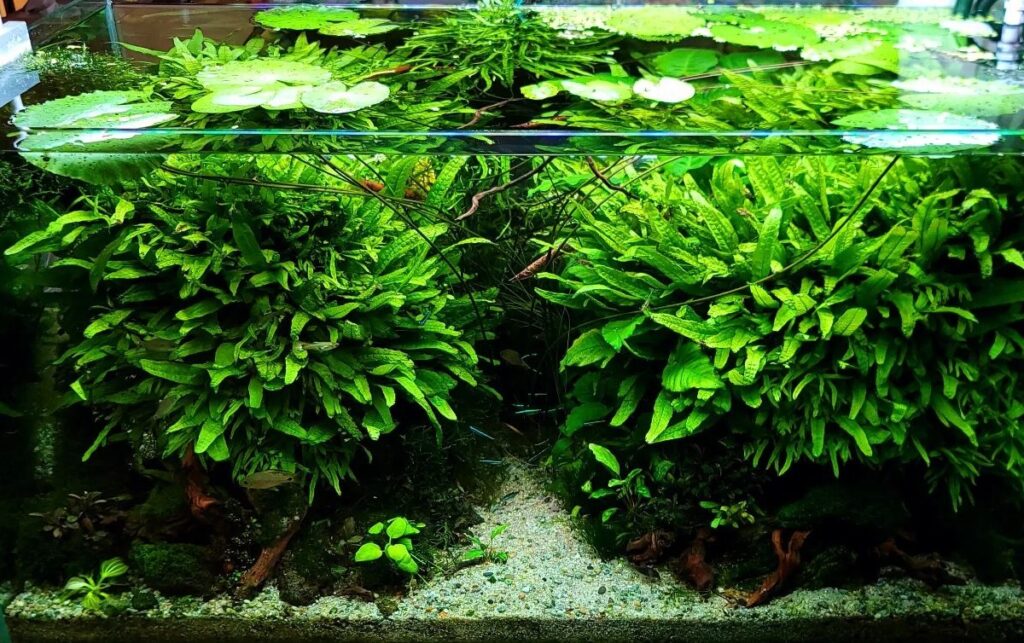
Java Fern is a popular low light aquarium plant native to Southeast Asia. It is an epiphytic plant, meaning it grows on surfaces like rocks or wood rather than being rooted in the substrate. Java Fern has long, slender, bright green leaves that can grow up to 12 inches in length. The leaves are leathery and tough, making them resistant to damage from fish. This plant is easy to care for, making it a great choice for beginner aquarists. It is slow-growing and requires little maintenance, with low to medium light requirements.
Anubias Barteri
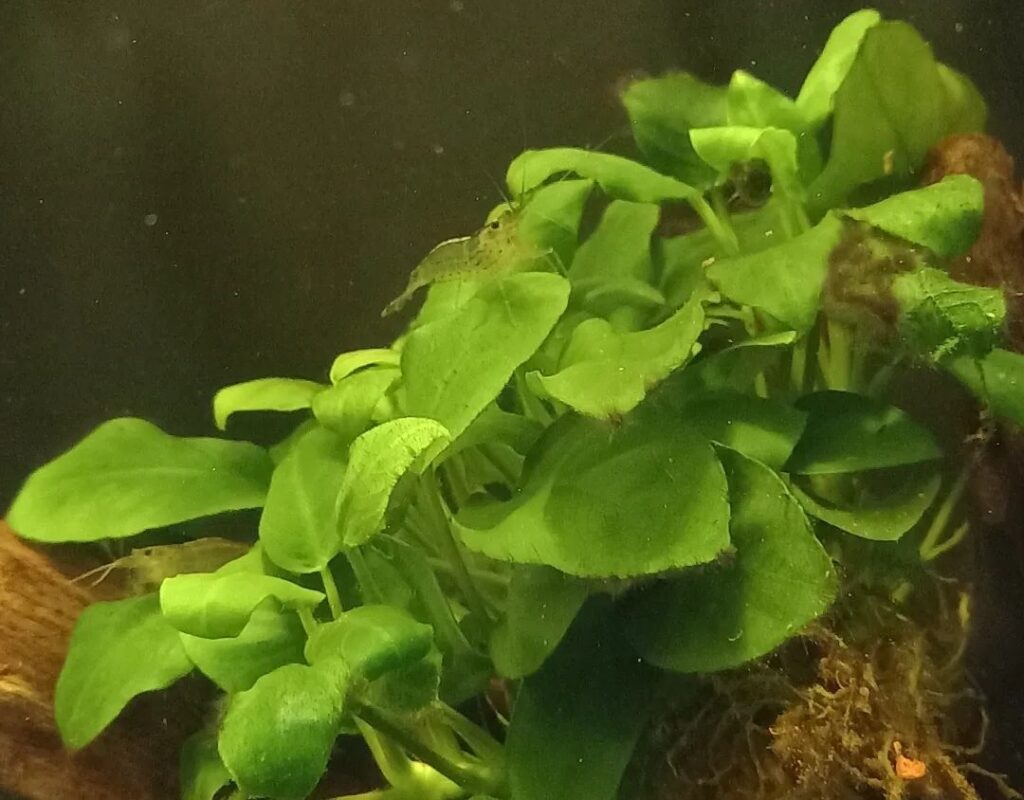
Anubias Barteri is a hardy, slow-growing plant native to West Africa. It is an excellent choice for low light aquariums due to its ability to thrive in low light conditions. Like Java Fern, Anubias Barteri is an epiphytic plant and can be attached to rocks, driftwood, or other decorations. The plant has dark green, rounded leaves that can grow up to 5 inches long. Anubias Barteri is also resistant to being eaten by most fish, making it a great addition to a variety of aquarium setups.
Marimo Moss Balls
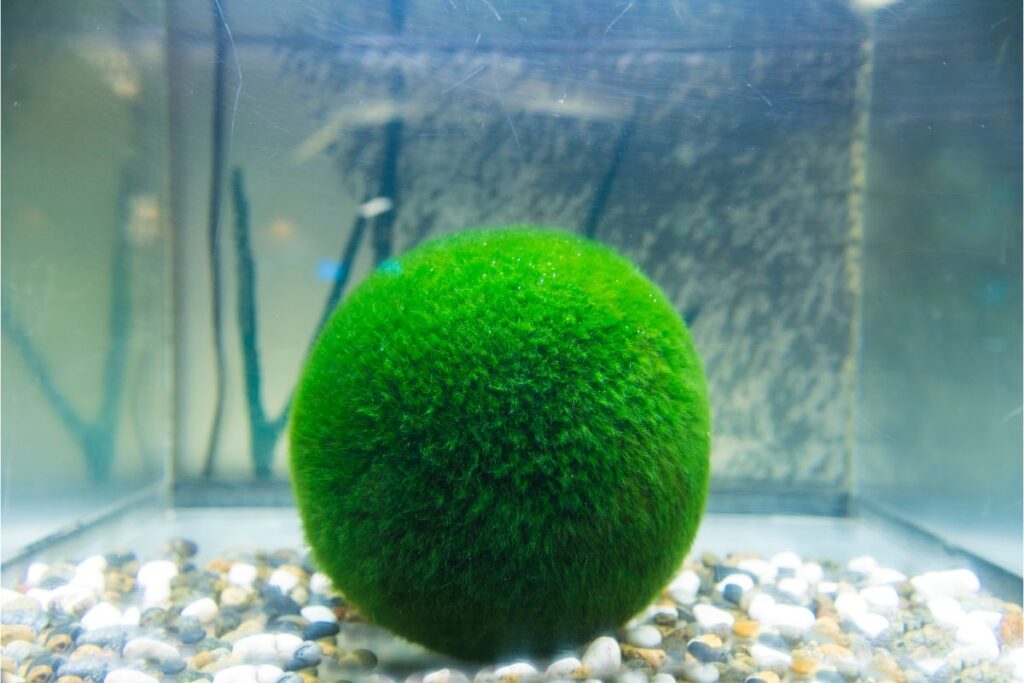
Marimo Moss Balls are a unique type of algae that form spherical shapes. They are native to several freshwater lakes in Japan, Iceland, and Estonia. Marimo Moss Balls are not technically plants, but they function similarly in an aquarium setting. They can tolerate low light conditions and help to absorb excess nutrients in the water, aiding in water quality maintenance. Marimo Moss Balls are easy to care for, requiring only occasional gentle rolling to maintain their shape and low to medium light levels.
Amazon Sword

The Amazon Sword is a popular plant native to the Amazon River basin. It is known for its large, broad leaves that can grow up to 20 inches long, providing excellent cover and hiding spots for fish. Amazon Swords are adaptable plants that can survive in low light conditions, but they will grow more slowly and may have smaller leaves. They do require a nutrient-rich substrate for optimal growth and may need additional fertilization in low light setups.
Related Post:
Can Plants Grow In Sand Aquarium?
Cryptocoryne Lucens
Cryptocoryne Lucens is a smaller species of Cryptocoryne plants native to Sri Lanka. It is a great choice for low light aquariums due to its ability to thrive in low light conditions. Cryptocoryne Lucens has narrow, elongated leaves that grow in a rosette pattern, reaching up to 6 inches in height. The leaves are typically a bright green color and can develop a slight bronze tint in some conditions. This plant is relatively easy to care for and can be grown in a variety of substrates, though a nutrient-rich substrate is recommended for optimal growth.
Vallisneria Americana
Also known as Jungle Val or American Eelgrass, Vallisneria Americana is a low light, fast-growing, and hardy aquatic plant. It features long, ribbon-like leaves that can grow up to several feet in length, providing a lush, jungle-like appearance to the aquarium. This plant is an excellent choice for beginners, as it can tolerate a wide range of water conditions and does not require extensive care. Vallisneria Americana propagates through runners, and it can quickly form dense clusters that serve as a natural habitat for fish and invertebrates.
Dwarf Sagittaria
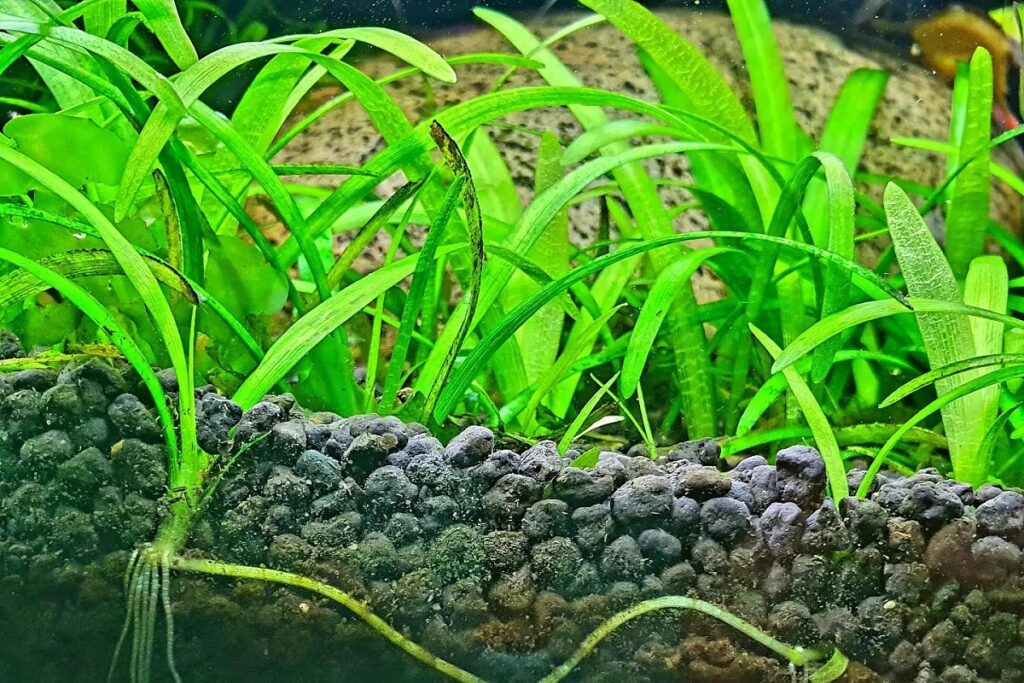
Dwarf Sagittaria, or Sagittaria subulata, is a low light foreground plant that is perfect for creating a carpet-like effect in the aquarium. It features small, grass-like leaves that grow in dense clusters and can reach up to 4 inches in height. This plant is relatively easy to care for, as it can adapt to various water conditions and does not require frequent trimming. Dwarf Sagittaria spreads through runners, eventually forming a lush green carpet that provides shelter for small fish and invertebrates.
Java Moss
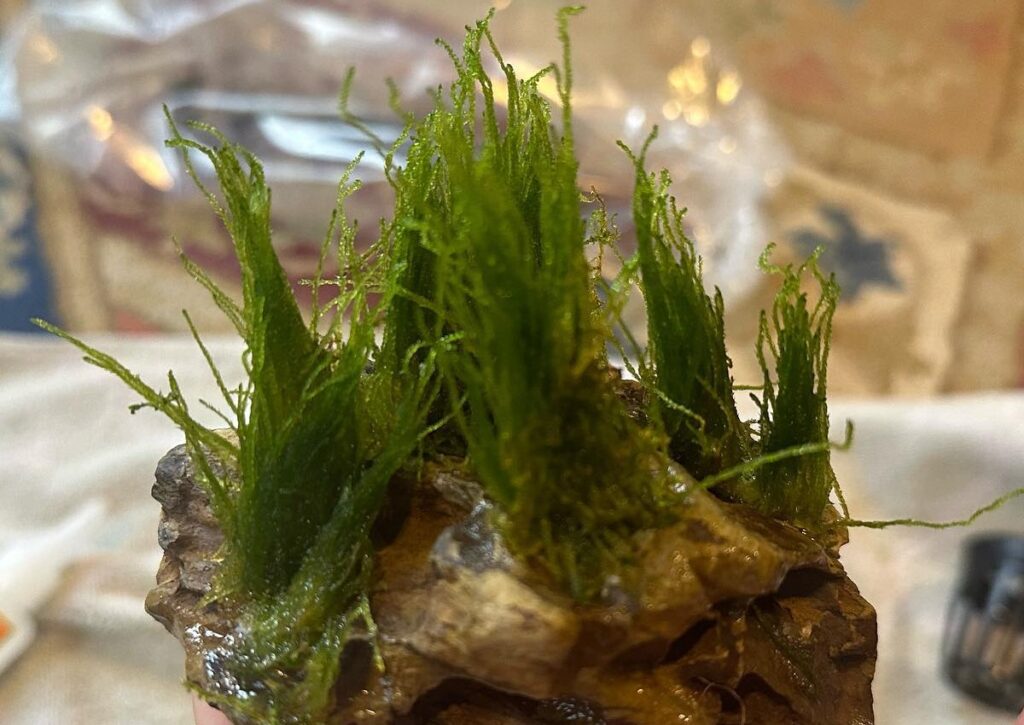
One of the most popular low light aquarium plants, Java Moss is a versatile and hardy option for any tank. It is a moss species that can attach itself to rocks, driftwood, and other tank decorations, creating a natural, textured appearance. Java Moss is low-maintenance and can grow in a wide range of water conditions. It also serves as a spawning ground for fish and a food source for shrimp and other invertebrates. Java Moss can be easily propagated by simply dividing and attaching it to new surfaces in the tank.
Pearl Weed
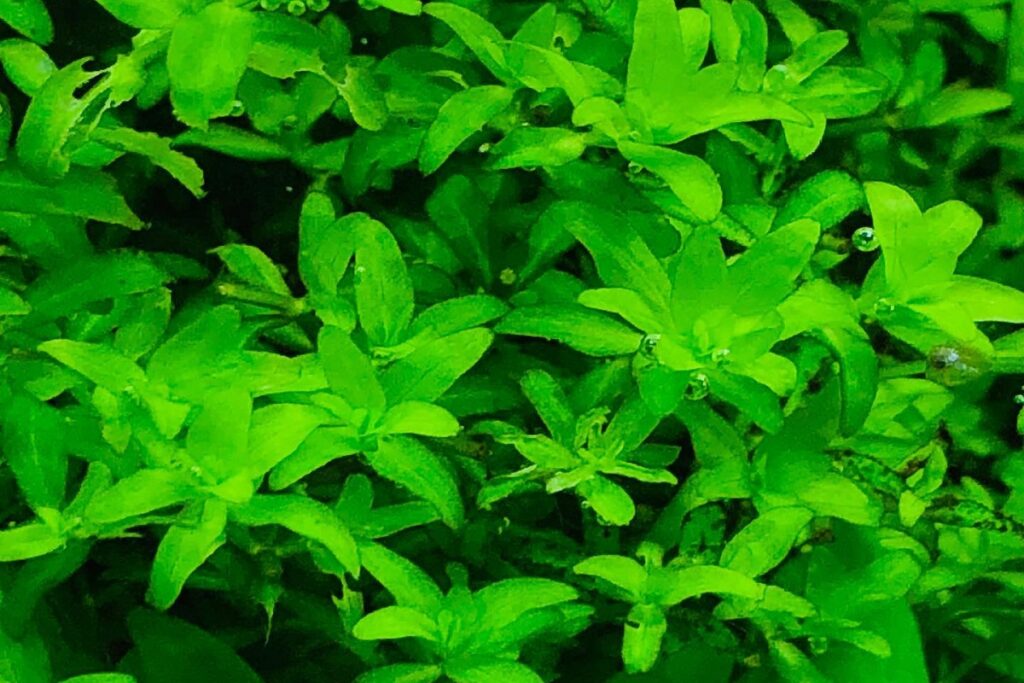
Pearl Weed is a versatile and attractive low light plant suitable for both foreground and midground placement in an aquarium. It features small, bright green leaves that grow along delicate stems, creating a bushy appearance. Pearl Weed can be grown as a carpet by trimming it regularly, or it can be allowed to grow taller for a more textured look. This plant is relatively easy to care for, as it can adapt to a variety of water conditions and does not require intense lighting. Pearl Weed can be propagated through stem cuttings or by allowing it to spread naturally in the aquarium.
Anacharis

Also known as Elodea or Brazilian Waterweed, Anacharis is a popular low light aquarium plant known for its fast growth and ease of care. It features long, thin, bright green leaves that grow along the length of its stems, giving it a feather-like appearance. Anacharis can be planted in the substrate or left to float freely in the water, providing a natural habitat and hiding spots for fish and invertebrates. This plant is an excellent choice for beginners, as it can tolerate a wide range of water conditions and does not require high light levels. Anacharis can be easily propagated through stem cuttings, which can then be planted in the substrate or left to float in the aquarium.
Rose Sword Plant
This is a hybrid aquatic plant known for its attractive red leaves. It is relatively easy to grow and can reach up to 16 inches in height, making it a popular choice for mid-ground or background planting in aquariums.
Water Sprite

Also known as Indian fern, water sprite is a fast-growing, floating plant that can also be planted in the substrate. It provides excellent cover and spawning sites for fish, and its rapid growth helps to keep algae in check by absorbing excess nutrients in the water.
Hornwort
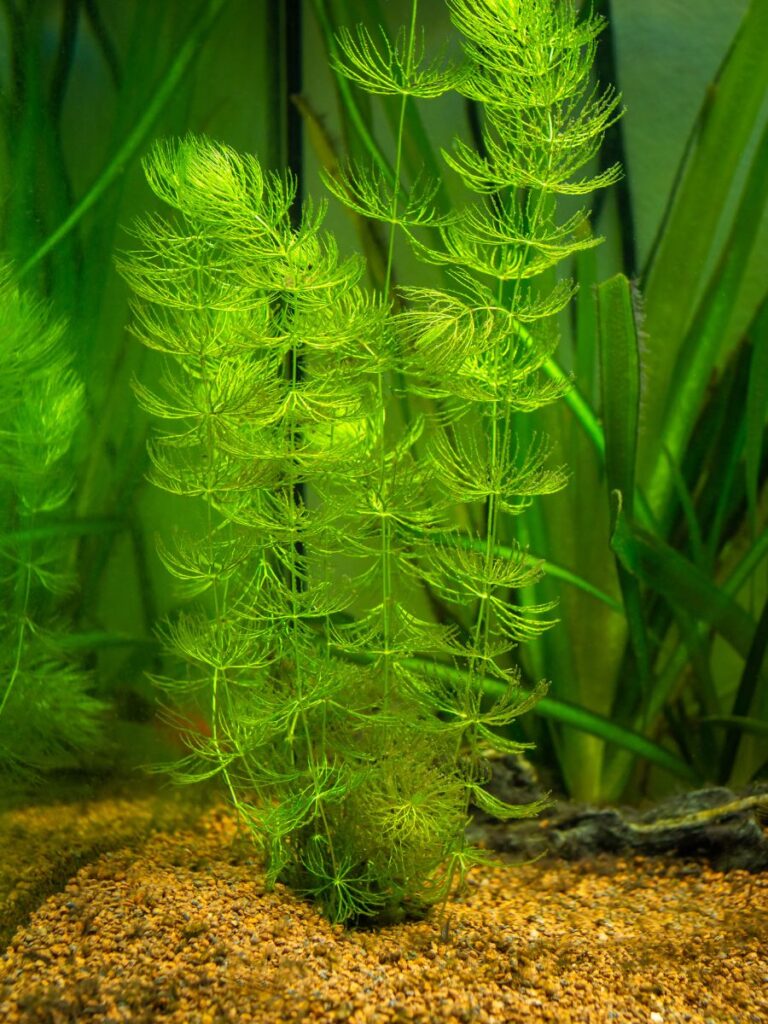
This is a versatile, low-maintenance plant that can be floated or anchored in the substrate. It grows rapidly and can reach up to 10 feet in length, providing excellent cover for fish and invertebrates. Its dense foliage also helps to remove excess nutrients and impurities from the water.
Christmas Moss
As its name suggests, this moss has a unique, branch-like structure that resembles a Christmas tree. It is easy to grow and can be attached to rocks, driftwood, or other surfaces in the aquarium to create a natural, lush look.
Bucephalandra

This is a genus of slow-growing, low-light aquatic plants native to Borneo. These plants come in a variety of shapes, sizes, and colors, and can be used to create beautiful and unique aquascapes. They are typically attached to rocks, driftwood, or other surfaces in the aquarium.
Cryptocoryne Wendtii
This is a popular low light aquarium plant native to Sri Lanka. It has long, narrow leaves that can vary in color from green to brown or red, depending on the conditions. It is a hardy plant that can tolerate a wide range of water conditions, making it an excellent choice for beginners.
Dwarf Hairgrass
This small, grass-like plant is native to North America and Europe. It has thin, hair-like leaves that form a dense carpet in low light aquariums. Dwarf Hairgrass does well in low to moderate light and helps to oxygenate the water and provide shelter for small aquatic animals.
Floating Fern
Also known as Salvinia natans, this is a small, floating plant with delicate, fern-like leaves. It thrives in low light conditions and can help to reduce algae growth by shading the aquarium water. The roots of the Floating Fern also provide a habitat for small aquatic creatures.
Ludwigia Repens
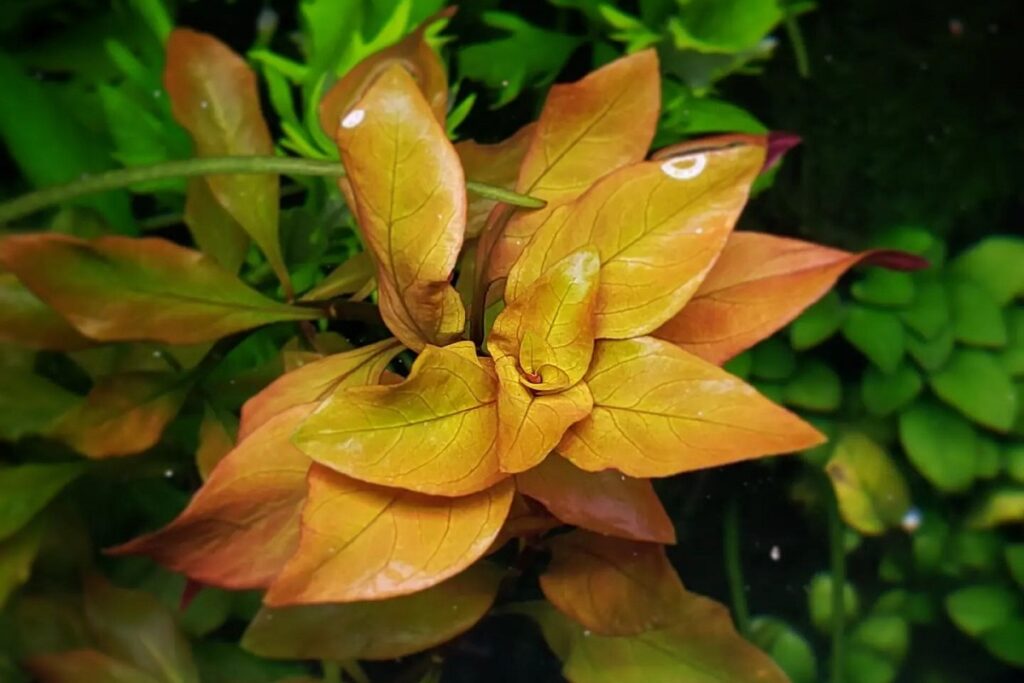
This is a versatile stem plant native to North and Central America. It has oval-shaped leaves that can range in color from green to red. Ludwigia Repens grows well in low light and can be left floating or planted in the substrate.
Anubias Nana
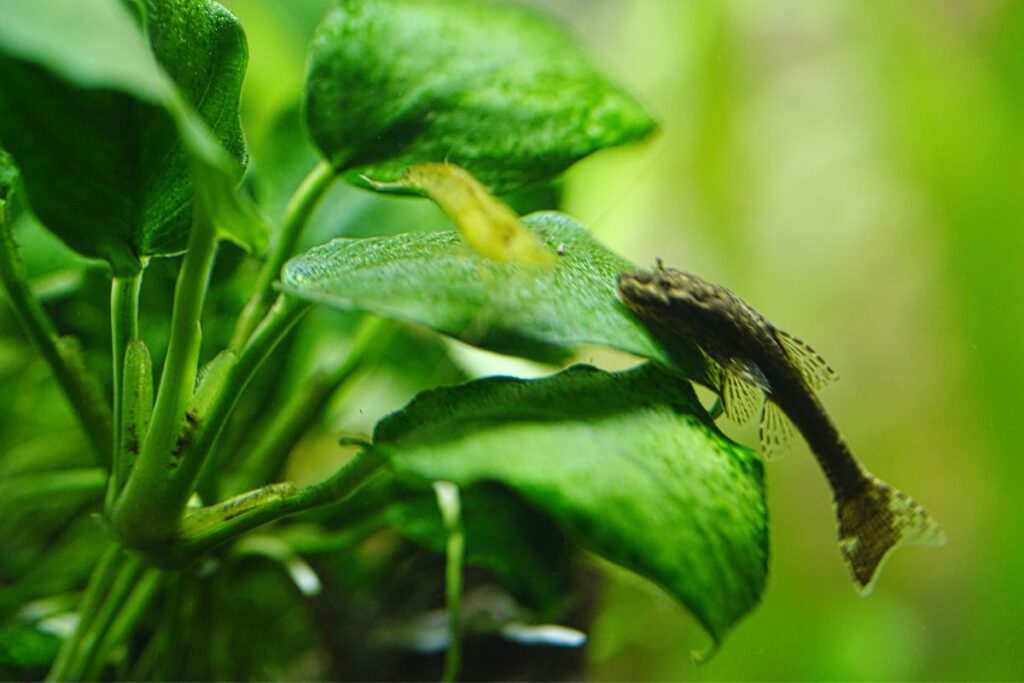
This is a small, slow-growing plant native to West Africa. It has dark green, thick leaves that can tolerate low light conditions. Anubias Nana can be attached to rocks or driftwood and is an excellent choice for adding greenery to the lower levels of an aquarium.
African Water Fern
Also known as Bolbitis heudelotii, this fern-like plant is native to Africa. It has finely divided leaves and can be grown either submerged or emersed. African Water Fern prefers low light conditions and can be attached to rocks or driftwood.
Green Hygro
This fast-growing plant, also known as Hygrophila polysperma, is native to Southeast Asia. It has bright green leaves and can grow both submerged and above the water. Green Hygro does well in low light conditions and can provide a lush, green backdrop for your aquarium.
Sunset Hygro
Also known as Hygrophila difformis, this plant has finely divided leaves that can turn red or pink under strong light. Sunset Hygro is native to Southeast Asia and can grow in low light conditions. It can be planted in the substrate or left floating in the aquarium.
Rotala Rotundifolia
This stem plant is native to Southeast Asia and has small, round leaves that can turn red under strong light. Rotala Rotundifolia grows well in low light and can be planted in the substrate or left floating in the aquarium.
Rotala Indica
This is another stem plant native to Southeast Asia, with small, round leaves that can turn red under strong light. Rotala Indica grows well in low light and can be planted in the substrate or left floating in the aquarium.
Parrots Feather
Also known as Myriophyllum aquaticum, this plant has feathery, bright green leaves that grow along a central stem. Parrots Feather is native to South America and can grow in low light conditions. It can be planted in the substrate or left floating in the aquarium.
Moneywort
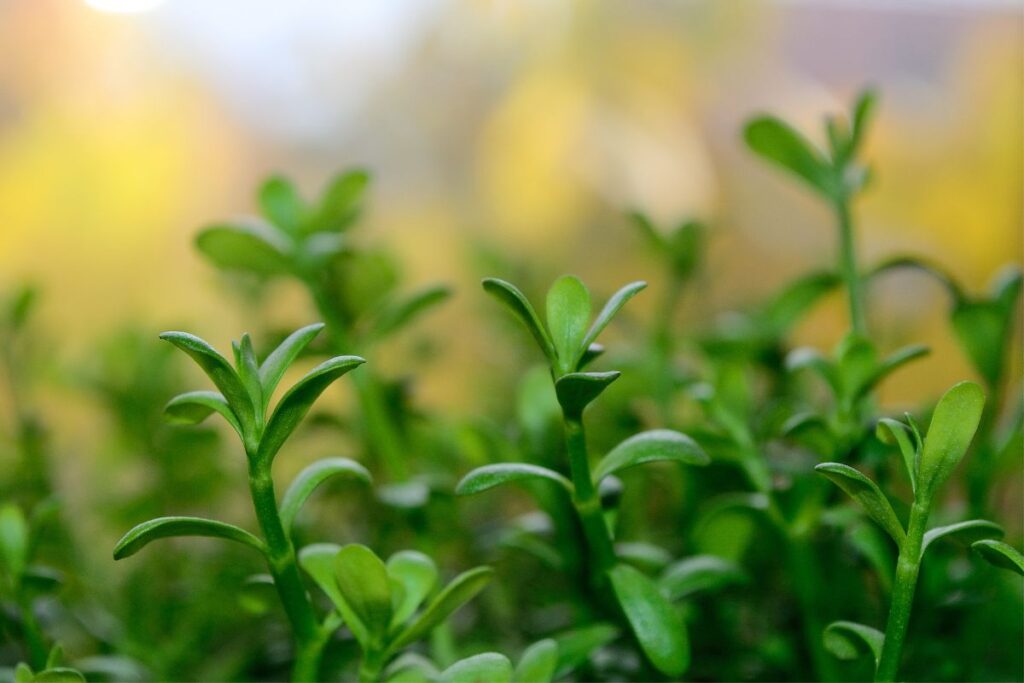
This plant, also known as Bacopa monnieri, is native to Asia and has small, round leaves that grow along a central stem. Moneywort does well in low light conditions and can be planted in the substrate or left floating in the aquarium. It is often used as a background plant due to its fast growth and dense foliage.
Brazilian Pennywort
This is a versatile and fast-growing plant that can thrive in low light conditions. It has round, coin-shaped leaves and can grow in a variety of ways, such as floating, planted, or cascading down from the top of the tank. This plant can provide shade and shelter for fish and invertebrates.
Cryptocoryne Balansae
This plant has long, slender leaves that can reach up to 12 inches in length. It is a low light plant that grows slowly and does well in both soft and hard water conditions. It is often used as a background plant in aquariums due to its height and attractive appearance.
Cryptocoryne Spiralis
This is a tall, narrow-leaved plant that can grow up to 16 inches in height. It is a low light plant that is often used as a background or midground plant in aquariums. The leaves are twisted, giving the plant a unique appearance.
Cryptocoryne Usteriana
This is a large, robust plant with long, wavy leaves that can grow up to 18 inches in length. It is a low light plant that prefers soft water conditions. It is often used as a background or midground plant in aquariums.
Guppy Grass
This is a fast-growing, low light plant that provides excellent hiding spots and breeding grounds for fish and invertebrates. It can be left floating or planted in the substrate and will grow well in a variety of water conditions.
Related Post:
Can Plants Grow In Gravel Aquarium?
Pelia Moss
This is a low light, slow-growing plant that forms dense, green cushions. It can be attached to rocks, driftwood, or other surfaces in the aquarium and provides hiding spots for small fish and invertebrates.
Waterwheel Plant
This unique, floating carnivorous plant captures and digests small aquatic creatures. It does well in low light conditions and can add an interesting element to an aquarium.
Bacopa
This is a low light, slow-growing plant with small, round leaves that grow along a stem. It can be planted in the substrate or left floating and provides hiding spots for fish and invertebrates.
American Waterweed
This is a fast-growing, low light plant that can be left floating or planted in the substrate. It provides oxygen to the water and serves as a hiding spot for fish and invertebrates.
Micro Crypt
This is a small, low light plant with narrow, wavy leaves. It is often used as a foreground plant in aquariums and does well in soft water conditions.
Duckweed
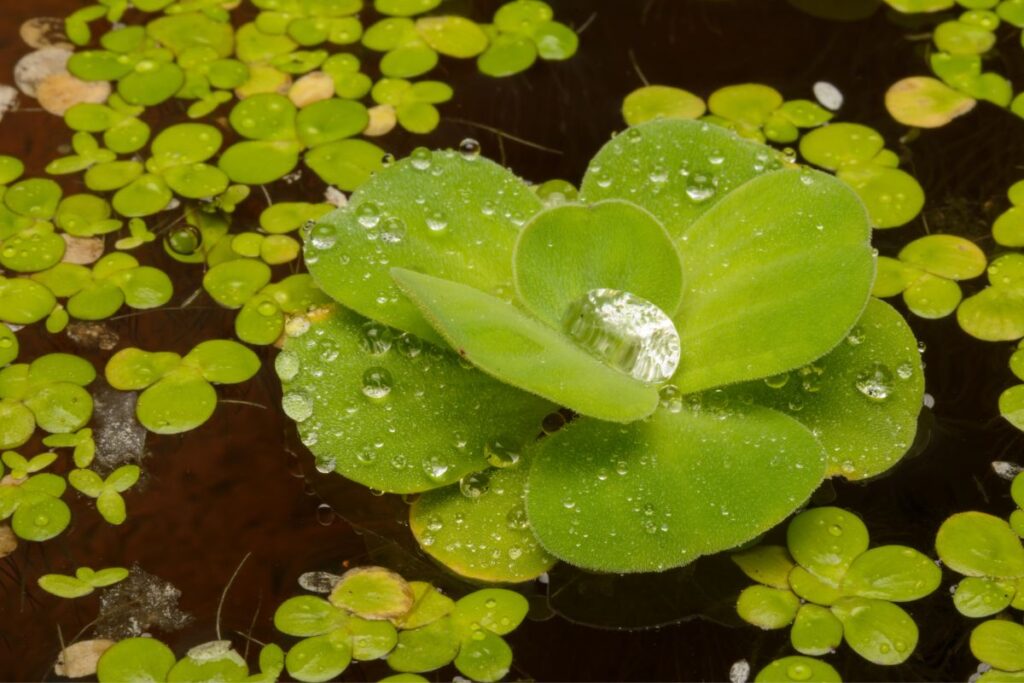
This is a very small, floating plant that can quickly cover the surface of an aquarium, providing shade and shelter for fish and invertebrates. It is a low light plant that can also help to control excess nutrients in the water.
Cryptocoryne Lutea
This is a low light plant with long, slender leaves that can grow up to 6 inches in length. It is often used as a midground or background plant in aquariums and does well in both soft and hard water conditions.
FAQs
Can Aquarium Plants Survive Without Light?
Aquarium plants, like all photosynthesizing organisms, rely on light as their primary energy source to grow and thrive. However, some aquatic plants can survive without light for short periods, but this is not ideal for their long-term health and growth. The ability to survive without light will depend on the plant species, their stored energy reserves, and the conditions in the aquarium.
In low-light or no-light situations, aquarium plants will gradually lose their ability to perform photosynthesis. As a result, they will consume their stored energy reserves to maintain basic metabolic functions. This will eventually lead to decreased growth, yellowing or browning of leaves, and in severe cases, the death of the plant. Some hardy, low-light plant species, such as Java fern and Anubias, may fare better in these conditions than more delicate, light-demanding species. However, even these hardy plants will eventually suffer from a lack of light.
To ensure the health and growth of aquarium plants, it is crucial to provide them with a suitable light source, such as LED or fluorescent lights designed specifically for aquatic plant growth. These lights should be kept on for an appropriate photoperiod, typically between 8-12 hours per day, to mimic natural daylight conditions. This will enable the plants to photosynthesize effectively and maintain their overall health and appearance. Additionally, proper nutrient supplementation and CO2 levels will further support the growth and vitality of aquarium plants.
How Much Light Do Low Light Aquarium Plants Need?
Low light aquarium plants typically require a light intensity of around 10 to 15 micromoles of photons per square meter per second (µmol/m²/sec). This level of light is sufficient for their growth and photosynthesis, without causing issues like excessive algae growth or stressing the plants.
In terms of wattage, low light aquarium plants generally require around 1 to 2 watts per gallon of water, although this may vary depending on the specific plant species and the efficiency of the lighting system being used. LED lights or fluorescent bulbs are recommended for low light aquariums, as they provide the appropriate light spectrum and intensity needed for plant growth. It’s also important to maintain a consistent photoperiod, meaning the duration of light exposure per day, which is typically around 8 to 10 hours for low light plants. In addition, make sure to regularly monitor the health of the plants and adjust the lighting as needed to ensure optimal growth and overall aquarium health.
Can Aquarium Plants Grow In Blue Light?
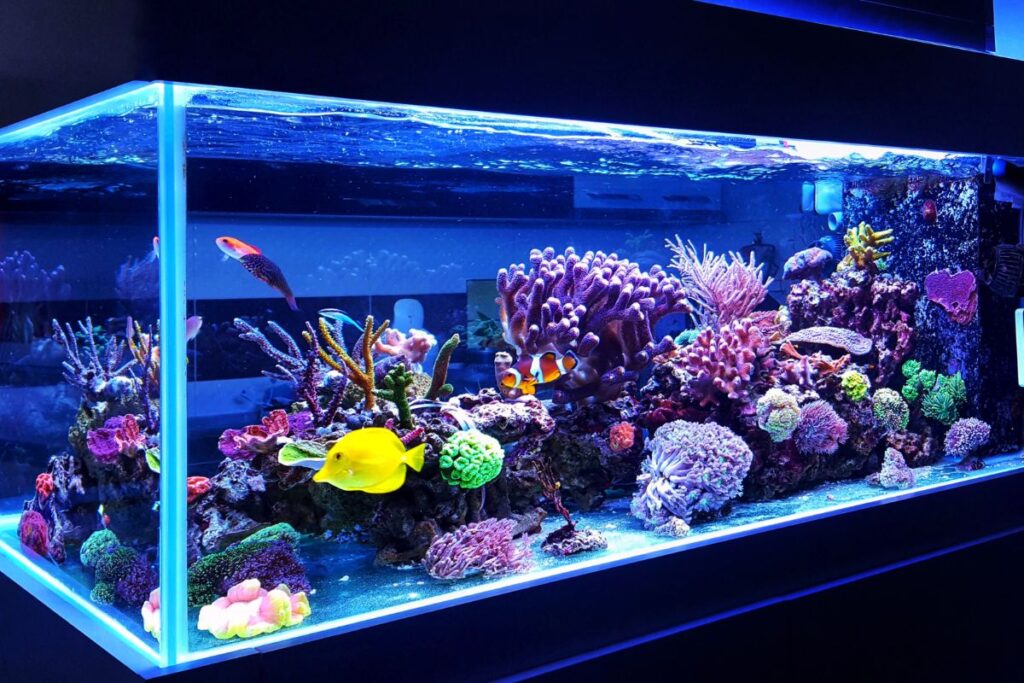
Aquarium plants can grow in blue light, as it is one of the essential light spectrums required for their growth and photosynthesis. Blue light has a wavelength of around 400-500 nanometers, which penetrates water more efficiently than other light spectrums. This makes it particularly important for aquatic plants, which often grow in low light conditions. Blue light encourages vegetative growth, root development, and overall plant health, making it ideal for aquarium plants.
However, it is important to note that relying solely on blue light may not be sufficient for optimal plant growth. Aquarium plants also require red light (wavelength of around 600-700 nanometers) for photosynthesis and proper development. A combination of blue and red light is necessary to promote robust growth and maintain the health of aquatic plants. Therefore, it is beneficial to use full-spectrum LED lights or specialized aquarium lights that provide the necessary balance of blue and red light for aquarium plants. Combining these light spectrums will ensure that your aquarium plants receive the appropriate wavelengths for growth, vibrant colors, and overall health.
Conclusion
Yes, aquarium plants can survive without enough light. Low light aquarium plants require little to no direct sunlight in order for them to flourish. So if you’re looking for a way to add some vibrant colors and texture to your fish tank, then these low light aquarium plants might be exactly what you need! With a bit of patience and love, they will help bring life into any home or office space with their captivating beauty.
